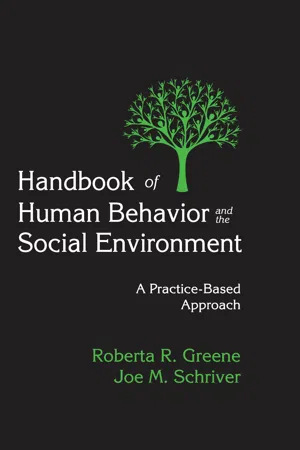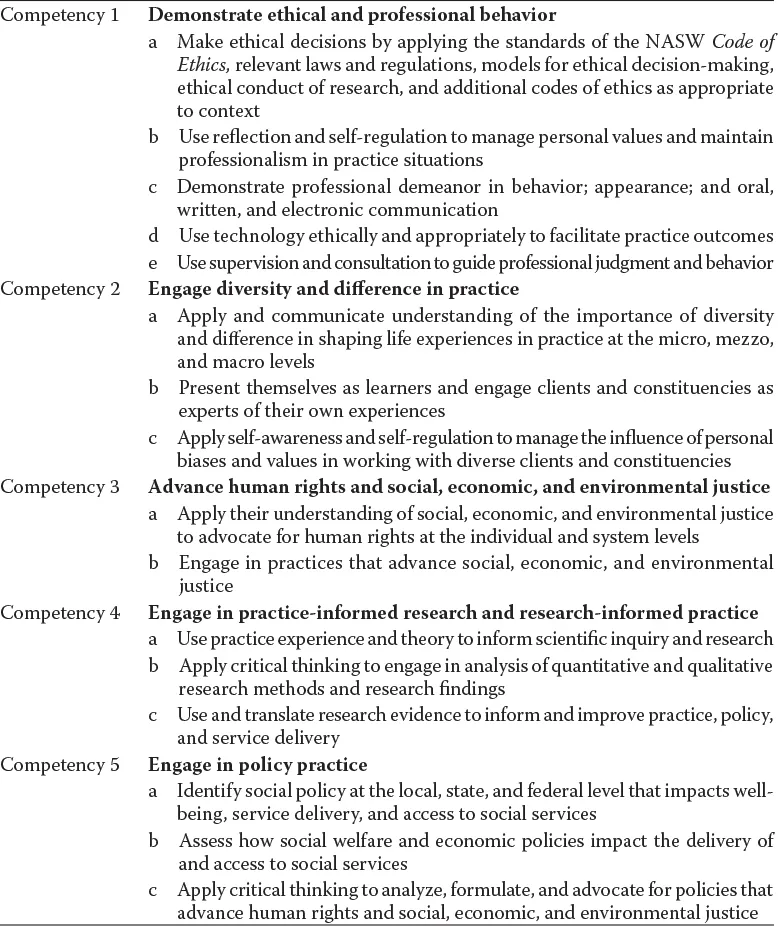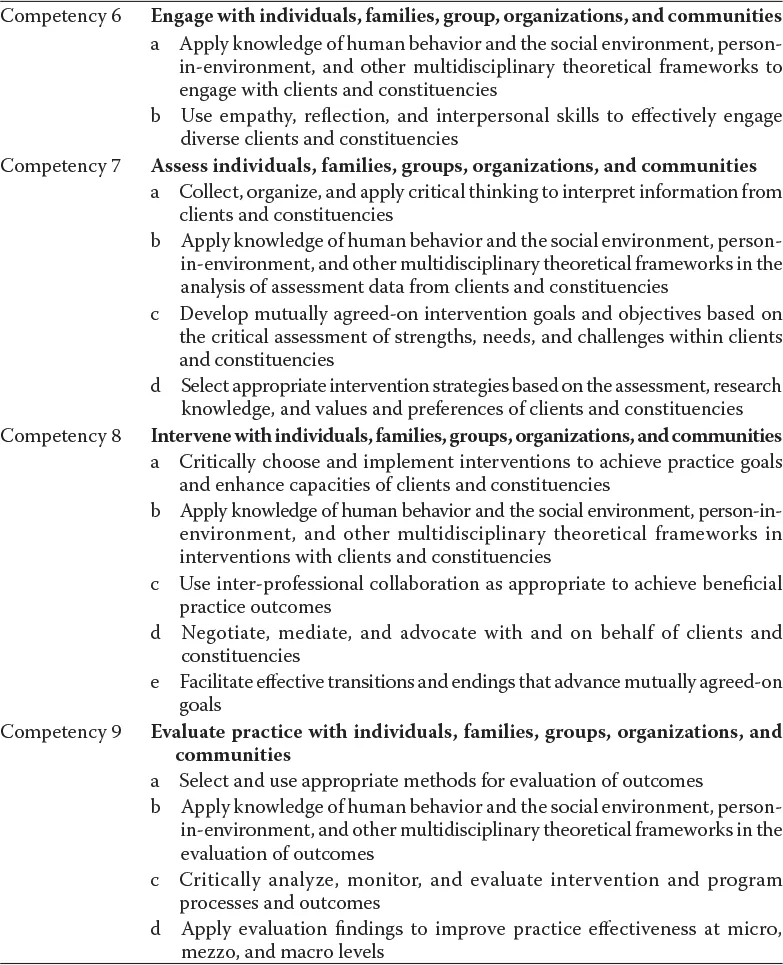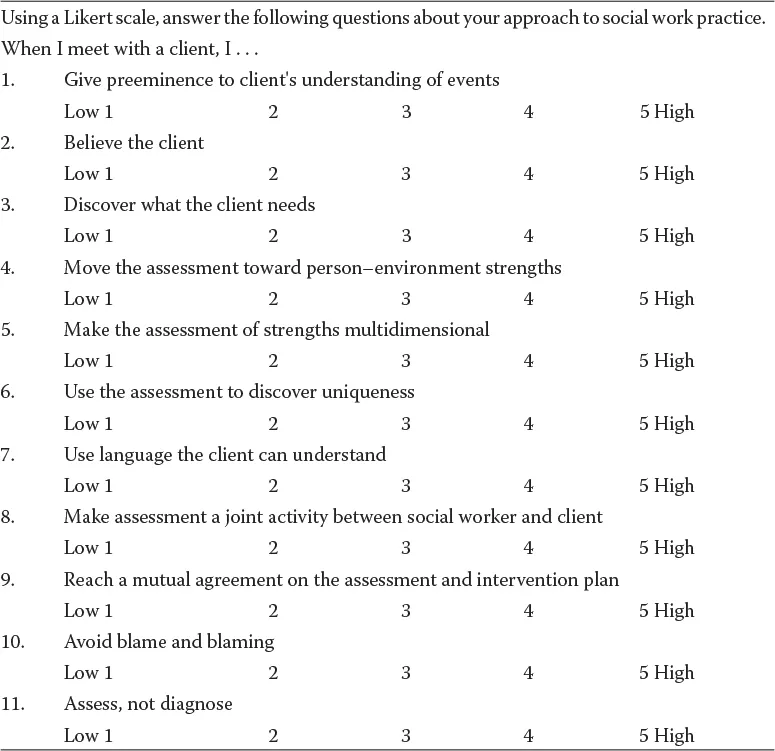
Handbook of Human Behavior and the Social Environment
A Practice-Based Approach
- 258 pages
- English
- ePUB (mobile friendly)
- Available on iOS & Android
Handbook of Human Behavior and the Social Environment
A Practice-Based Approach
About This Book
Handbook of Human Behaviour and the Social Environment is a compendium of new theories for all aspects of social work practice. It pulls together major theories and concepts used in the field. By synthesizing this wide knowledge base via practical points of view and tracing the socio-historical evolution of its content and the role of the social worker, this handbook will assist social workers in achieving their primary goals: fostering human well-being and competent social functioning.The authors describe the current social work curriculum developed by the Council on Social Work Education Commission on Educational Policy and Accreditation Standards, demonstrating how client and constituency engagement, assessment, intervention, and evaluation are guided by knowledge of human behaviour and the social environment (HBSE) theory. The Handbook applies HBSE theories differently depending on client system size, context, and needs. Major concepts include power, oppression, and identity formation.This essential, up-to-date volume formulates strategies to eliminate personal bias and to promote human rights. In addition, it integrates ethics, research, policy content, diversity, human rights, and social, economic, and environmental justice issues. It will serve as an insightful and influential guide to students, professors, and social workers.
Frequently asked questions
Information
1
Introduction: Theory-Informed Social Work Practice
- This chapter introduces the HBSE Handbook, a state-of-the-art compendium of key theories applied in the social work profession.
- The chapter also describes the current social work curriculum officially developed by the Council on Social Work Education Commission on Educational Policy and Accreditation Standards.
- In addition, it discusses the CSWE 2015 mandate that human behavior and the social environment be used to inform and guide the processes of client engagement, assessment, intervention, and evaluation with individuals, families, groups, organizations, and communities.
Social Work Practice Competency
2015 Educational policy and accreditation standards competencies and practice behaviors


Enhancing Our Professional Purpose and Weil-Being
- Social work's mission is to enhance human well-being and help meet the basic human needs of all people, with particular attention to the needs and empowerment of people who are vulnerable, oppressed, and living in poverty. A historic and defining feature of social work is the profession's focus on individual well-being in a social context and the well-being of society. Fundamental to social work is attention to the environmental forces that create, contribute to, and address problems in living. (NASW 2008,1)
- The purpose of the social work profession is to promote human and community well-being.... [Moreover], social work's purpose is actualized through its quest for social and economic justice, the prevention of conditions that limit human rights, the elimination of poverty, and the enhancement of the quality of life for all persons. (CSWE 2015a, 1)
Improving Human and Community Well-Being
Improving Societal Conditions
Maslow's hierarchy of needs. (From Huitt 2007).

Theory-Informed Social Work Practice with Individuals, Families, Groups, Communities, Organizations, and Societies
- My client is hoping to be understood. What are the right questions to ask?
- What will happen in the first meeting?
- What ideas does the client have about what would make things better?
To what extent do I assess client strengths?

- Will I, as a social worker, be a good listener?
- Will I know in what ways I can be helpful?
- Will I have the ability to help the client—individual, family, organization, or community—clarify and assess the issues at hand?
- What will be the area of our mutually defined work and strategies for intervention?
- Will I be able to effectively advocate for and against policies affecting my clients and constituencies?
- Will I be able to practice in culturally sensitive ways at all system levels?
- Will I be able to understand and respond, in partnership with the client system, to contextual issues of social and economic justice, discrimination, and oppression that have a negative impact on achieving our mutually agreed upon outcomes?
Interviews: Clients
Interviews: Constituencies
Engagement with Individuals, Families, Groups, Organizations, and Communities
- What personal and societal factors may negatively impact client and constituency social functioning and quality of life...
Table of contents
- Cover Page
- Half Title
- Title
- copyright
- Contents
- Tables and Figures
- Preface
- 1 Introduction: Theory-Informed Social Work Practice
- 2 Human Behavior and the Social Environment: An Ecological Base
- 3 Human Behavior and the Social Environment: Engaging Diversity and Difference in Practice
- 4 Developmental Theories
- 5 Human Behavior and the Social Environment Theory: Social Work Practice with Individuals
- 6 Human Behavior and the Social Environment Theory: Social Work Practice with Families
- 7 Human Behavior and the Social Environment Theory: Social Work Practice with Groups
- 8 Human Behavior and the Social Environment Theory: Social Work Practice with Organizations
- 9 Human Behavior and the Social Environment Theory: Social Work Practice with Communities
- 10 Risk and Resilience Theory: A Bridge from Neuroscience to the Global Ecology